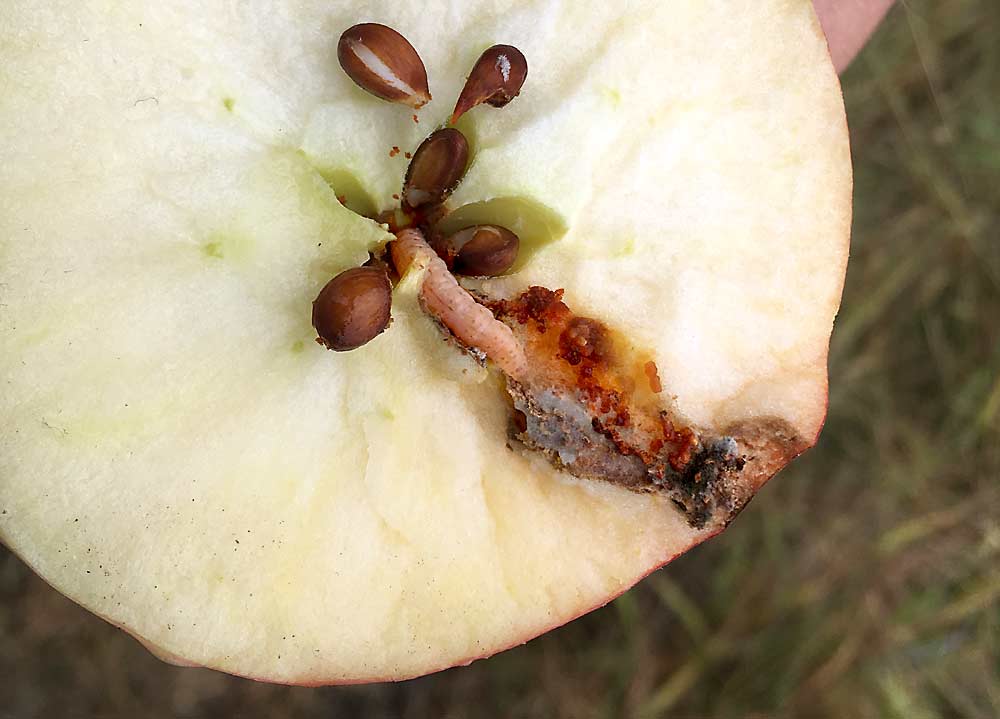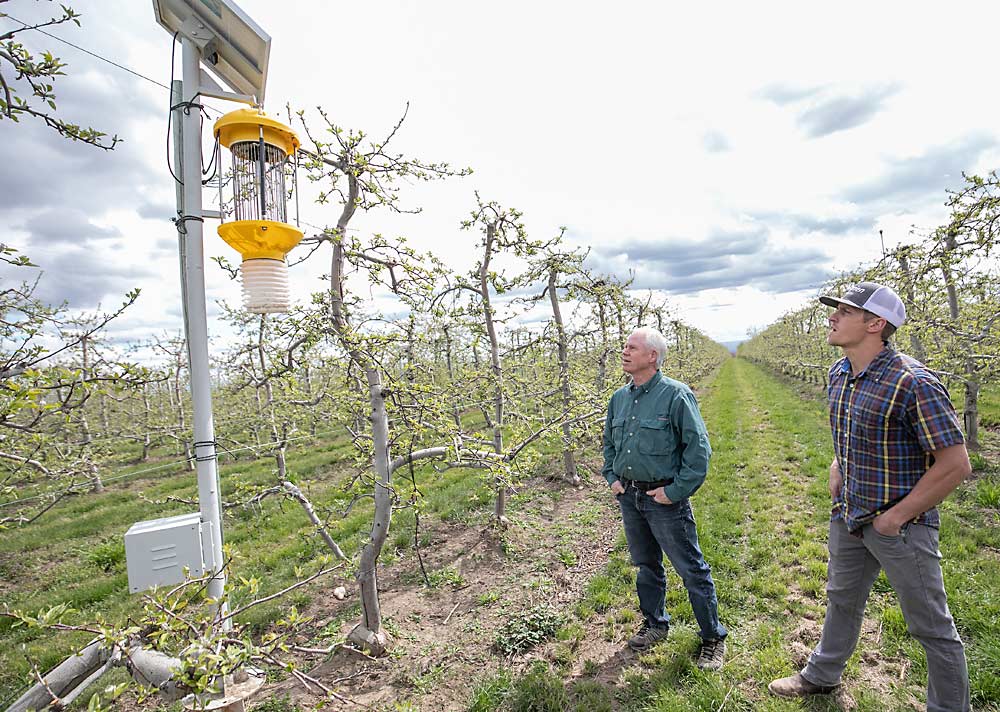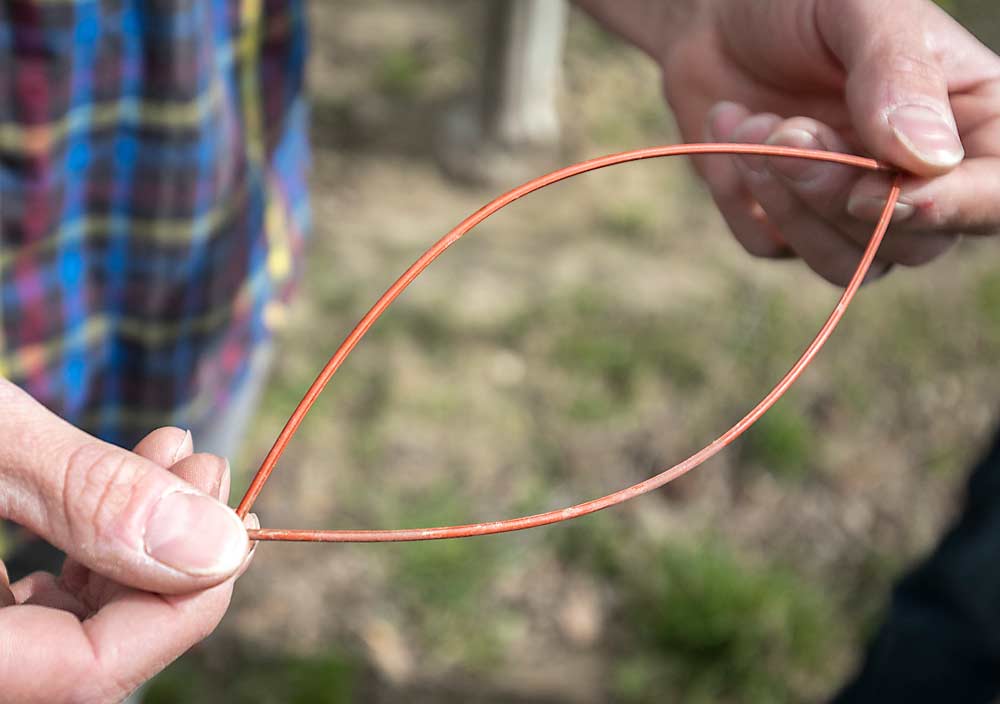
Growers in Washington drop sterile moths from the sky, hang bug zappers and try boosting their pheromone dispenser densities. Some have tried emitters networked to on-farm weather stations. Consultants and growers spend the preseason discussing strategies.
The state’s apple industry is throwing every tool it can find at what appears to be a resurgence of codling moth.
“We’re doing kind of out-of-the-box thinking,” said Leroy Groeneweg, a crop consultant for G.S. Long in Yakima.
Once considered reasonably controlled with pheromone disruption and finely tuned spray programs, the invasive pest has been causing more damage in recent years. Researchers haven’t quantified the problem, though anecdotal reports from growers say it’s there. “The feedback loop is saying, ‘Yes, we have more pressure,’” said Betsy Beers, a Washington State University entomologist.
Codling moth is an invasive pest that originated in Asia Minor but has been a major concern for apple and pear growers for more than 200 years, according to WSU. The larvae bore directly into the core of fruit, leaving it unmarketable.
Theories explaining the resurgence vary, Beers said.
For one, with changing weather has come more variability in spring conditions that sometimes opens the window to a third generation, instead of only two. On balance, warming has added 400 degree days to the codling moths’ season, according to climate research from California and Washington, recently published by Larry Gut, an entomologist from Michigan State University. That’s about half of a generation.
Michigan, however, has not seen a rise in codling moth pressure recently, said Gut, who has been working with Beers on sterile release trials in both states.
The rise of organic farming may play a part, but even conventional growers use softer tools now, after the potent broad-spectrum organophosphate Azinphos-methyl was completely banned by the U.S. Environmental Protection Agency in 2013, after a 12-year phaseout period. Alternatives work but leave less wiggle room for missed timing and other mistakes of execution.
Insecticide resistance could be a factor as well, while vertical integration in orchards sometimes leaves fewer sprayers to go around, meaning some blocks may be waiting longer than they should.

“Explore all options”
To combat the rise in codling moths, growers have been trying things they haven’t in the past.
Groeneweg and other field representatives sit down with their clients before the season to map out control strategies and discuss new ideas. They haven’t done that before, he said. Some put more pheromone emitters along the borders of their blocks. Other are trying mass trapping.
Denny Hayden of Pasco applied the virus Cyd-X roughly 24 times in 2019, about once every five days, a higher frequency than in the past. His neighbor, Conner Sullivan, also uses the virus but opted to pull out a block of older, less profitable trees that seemed to be a hot spot for codling moth. He also installed some solar-powered zappers in 2017. Most catch-and-kill traps used in the industry are liquid-based, though researchers are working on inexpensive zapper traps that use a combination of ultraviolet light and pheromones, said Alan Knight, an organic tree fruit adviser and former U.S. Department of Agriculture entomologist.
Both Hayden and Sullivan recently transitioned big portions of their orchards to organic. Entrust (spinosad) is a broad-spectrum spray certified for organic use, but it’s expensive and can throw off integrated pest management plans by killing beneficials.

Sullivan, Hayden and several other growers north of Pasco, near the Columbia River, signed up for sterile release when it became commercially available in 2019. Once a week, M3 Consulting Group of Phoenix visits their orchards, using drones to release sterile moths reared in Canada.
Beers, at WSU, is still evaluating the efficacy of sterile release in a research project, but plenty of growers have already signed up commercially. Hayden thinks the sterile release and his other efforts have paid off. In 2018, a warm year, he left entire blocks of Granny Smith apples unharvested due to codling moth damage. However, he saw few problems in 2019 when he used the more aggressive techniques. Also, he caught a lot of sterile moths in his traps.
Andy Arnold of Wahluke Heights Orchard near Mattawa also stepped up his virus program, increased the density of his pheromone emitters and started trap-and-kill in hot spots. Still, in 2018, the pressure grew so intense, one Honeycrisp block harvested only about half his expected volume.
So, last year, the organic grower reluctantly turned to Entrust. He also tried two rounds of beneficial nematodes, tiny nonsegmented worms he applies with a sprayer. The nematodes feed on codling moth larvae. He thinks his spring application helped, but he’s still on the lookout for other techniques.
“I’m going to explore all options,” he said.
Kelly Delay, a Royal City farm manager for CPC International Apple Co., figured modern codling moth populations called for more precision, so he purchased a high-tech monitoring program from Semios that helps him fine-tune degree-day models to his location.
“Anymore in this game, you better be on top of it,” Delay said.
For the past three years, Semios, a company with headquarters in Vancouver, British Columbia, has been installing networks of pheromone emitters equipped with canopy climate sensors, in-block weather stations and camera-equipped traps. The system aims to give growers a way to make timing decisions on the temperature, relative humidity and barometric pressure in their own blocks, rather than averages used in statewide degree-day models.
None of the techniques will offer a silver bullet, said Groeneweg of G.S. Long. He recommended growers consider all options and plan ahead to attack the first generation of codling moths, set up mating disruption on time and know when to spray. The variety of tools works, but they have to be timed right.
“It’s important to be on it in a proactive manner,” he said.
—by Ross Courtney
Related:
—It’s a matter of timing for codling moths
—Breeding bugs to fly and die – Video
—Just add water: Packaged nematodes bred to devour pests — Video






Leave A Comment